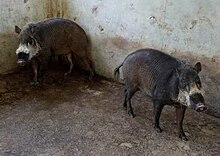Palawan bearded pig
| Palawan bearded pig | |
|---|---|

| |
| Scientific classification | |
| Domain: | Eukaryota |
| Kingdom: | Animalia |
| Phylum: | Chordata |
| Class: | Mammalia |
| Order: | Artiodactyla |
| Family: | Suidae |
| Genus: | Sus |
| Species: | S. ahoenobarbus
|
| Binomial name | |
| Sus ahoenobarbus Huet, 1888
| |

| |
| Synonyms | |
| |
The Palawan bearded pig (Sus ahoenobarbus) is a pig species in the genus It is 1 to 1.6 m (3.3 to 5.2 ft) in length, about 1 m (3.3 ft) tall and weigh up to 150 kg (330 lb).
Taxonomy
Until recently, it was considered a
species concepts, more study is required, but the presently available information seems to argue for full species status in any case.[2]
Fossils
excavated in Palawan were identified as being of the Palawan bearded pig, deer, Philippine long-tailed macaques, tiger, small mammals, lizards, snakes and turtles. From the stone tools, besides the evidence for cuts on the bones, and the use of fire, it would appear that early humans had accumulated the bones.[3][4]
Borneo might have been connected to Palawan during the penultimate and previous glacial periods, judging from the molecular phylogeny of murids.[5] Remains of pigs were compared with the wild boar (Sus scrofa)and Palawanese wild boar (Sus ahoenobarbus). It is known that the wild boar was imported as a domesticate to the islands from mainland Southeast Asia during the late Holocene.[6][7][8][9][10]
See also
References
- ^ . Retrieved 19 November 2021.
- .
- .
- ISBN 978-9-4024-1106-5.
- ISBN 9781444391282.
- S2CID 39923483.
- PMID 17360400.
- S2CID 55390219.
- doi:10.1002/oa.974.
- S2CID 161296257.

